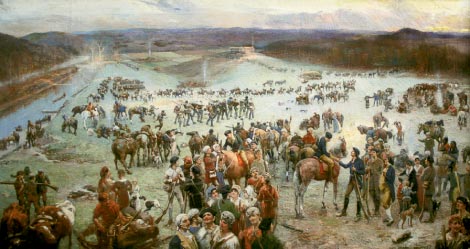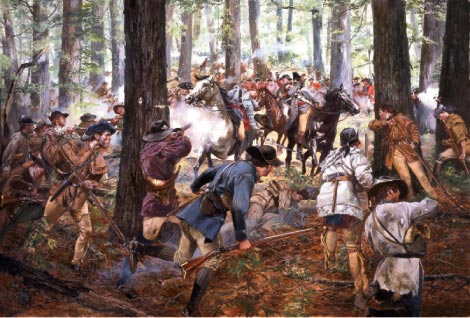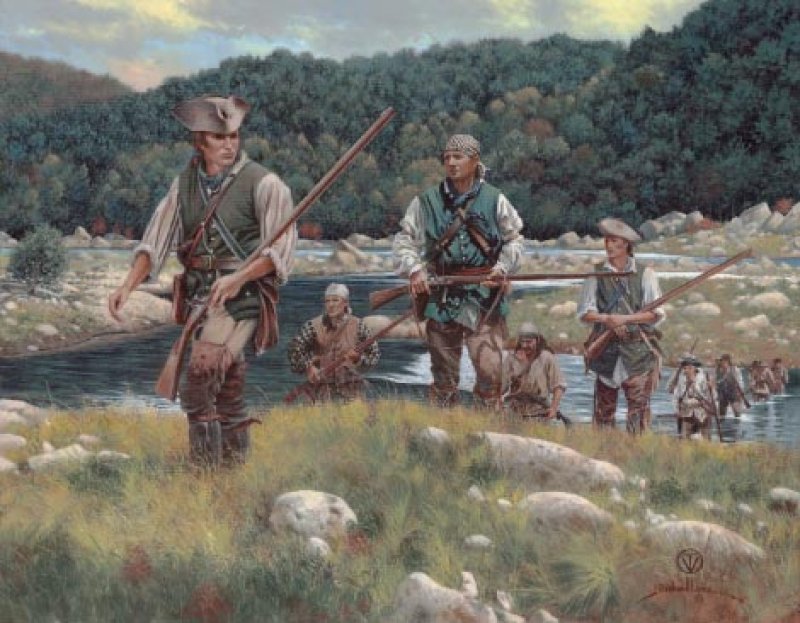The Long Road to Victory
The Long Road to Victory: Despite a difficult march and uneven odds, the Overmountain Men steered the Revolutionary War in the Patriots’ favor at Kings Mountain
The wind still howls through the Catawba Valley, along the shoals of the Watauga and Broad rivers. October colors still melt in a palette of red, yellow, and orange as they did 230 years ago. And the record of endurance required to make it through this rough backcountry to the battle that, as some say, saved the colonies from the British is no less incredible: More than 1,000 men marched 330 miles in 13 days, through rain and early snow. Sleeping under tents or trees, or not at all, the Overmountain Men kept their gunpowder dry, while they were soaked to the skin—emerging at the foothills to face one of King George’s most successful fighting forces in the South.
The rough edges and gutty purpose of these early Americans, who won the Battle of Kings Mountain and likely changed the outcome of the Revolutionary War, are harder to imagine. But it was desperate intention, as enduring as anything that ever happened in the Carolinas, that drove them in the autumn of 1780.
Who were these men? To be sure, they were woodsmen, as adept on foot as on horseback, professional hunters who had to be excellent marksmen. One observer called them “volunteers without wages or rations.” Everything from their supplies and horses to their gunpowder and lead had to be procured or stolen from the enemy.
Most of the Overmountain Men were Scots-Irish immigrants, who had pushed the fringe of the Western Frontier, fought Indians for their settlements, and didn’t take threats to their livelihoods lightly. They were Clevelands and McDowells, Morgans and Davies, Shelbys and Seviers, all names later chosen for cities, towns and counties in and around Western North Carolina. There were other familiar monikers among the troops, including Ingle, Gwaltney, and Vance. Davy Crockett’s father fought at Kings Mountain, as did Robert E. Lee’s. Their names still echo across the mountains, and beyond.

In his painting, Gathering of the Mountain Men at Sycamore Shoals, Lloyd Branson (1855-1926) depicts the muster of more than 1,000 men from Tennessee, Virginia, and North Carolina prior to their march to South Carolina. Far left: A North Carolina militiaman
Warpaths Converge
THE YEAR 1780 brought misery and war across the South. The British army held Savannah and Augusta, Georgia, and laid siege to the biggest prize, Charleston, South Carolina. General Benjamin Lincoln, torn between escape and defending Charleston, did nothing until Sir Henry Clinton was lobbing artillery at the city. It fell May 12, and with it a fifth of George Washington’s army, some 2,000 men, including most of North Carolina’s trained Continentals.
It was the worst Patriot defeat of the war. Then news of a devastating loss at Camden, South Carolina, and the stalemate at Ninety-six in Greenwood County reached the militiamen in Virginia, North Carolina, and what would become Tennessee.
A new level of violence was coming the Patriots’ way. Lord Earl Cornwallis, a general by rank, was already in Charlotte with an unopposed army of 2,500 men. Meanwhile, a mobile band of well-armed Loyalist dragoons raided at will along the border separating the Carolinas.
Still, the opposition remained active. Some led raids to harass and slow the progress of the British invaders, who seemed to grow more threatening every day. From his camp at Gilbert Town, near present-day Rutherfordton, Major Patrick Ferguson issued his ultimatum to all resisting forces in the region: Cease opposition to British arms, or he would “march his army over the mountains, hang their leader and lay their country waste with fire and sword.”
Meanwhile, a more bloodthirsty British commander named Banastre Tarleton, was earning an infamous reputation in the Carolinas. He had cut down more than 100 unarmed soldiers, remnants of the Continental Army from Charleston, as they tried to surrender near Waxhaws. “Tarleton’s quarter” (meaning “no mercy”) would be a rallying cry for the Overmountain Men.
“They were threatened,” says Hunt Boulware, a history professor at Western Carolina University in Cullowhee, regarding the swift response of the Overmountain Men. “They weren’t going to wait for Ferguson to come to them. It was very pragmatic.” And it proved to be perfect timing, as they eventually met Ferguson at a moment of vulnerability.
The Overmountain Men began marching from points north and west even before they knew where the fight would ensue.
Virginians and future Tennesseans gathered at Abingdon and Sycamore Shoals in their respective territories, while officers like Elijah Clarke and Colonel Edward Lacey followed the rumors of an impending battle from Georgia and Upstate South Carolina to join the fray.
The militia colonels had picked William Campbell to lead them, partly because he was the only senior officer not from North Carolina, which would stifle jealousies. Campbell also stood six-feet six-inches tall and had an unexcelled reputation for making his size and strength count in close-quarters combat. He brought the largest contingent, about 400 men. The Virginians had joined up with militias from the Wilkes-Surrey counties border area, who hiked about 80 miles along the Yadkin River to reinforce some of the Overmountain Men coming from farther north.
Ferguson remained cocky, even when he learned a large force of mountain men was assembling dangerously close. Or maybe he didn’t believe that these so-called mongrels—or “backwater men,” as he preferred to call them—could organize so swiftly across rough terrain to catch him. Still, he sent riders to ask Cornwallis and Tarleton for reinforcements. None came, so he started slowly moving south from Gilbert Town.
Lines are Drawn
On October 5, Ferguson sent a dispatch to Cornwallis in Charlotte: “I am on my march toward you, by a road leading from Cherokee Ford, north of Kings Mountain. Three or four hundred good soldiers, part dragoons, would finish the business. [Something] must be done soon. This is their last push in this quarter, and they are extremely desolate and [c]owed.”
On the same day, Patriot Colonel Edward Lacey arrived at Alexander’s Ford on the Green River south of Rutherfordton with 200 militiamen from South Carolina, and a better fix on Ferguson’s position. Lacey was at first viewed with suspicion as a spy before the motley group trusted his local knowledge and headed east from the river to Kings Mountain. The Overmountain Men were stronger in number and closer to Ferguson than they expected.
A day later, Ferguson sent his last message to Cornwallis, who was less than 50 miles away: “I have arrived today at Kings Mountain. I have taken a post where I do not think I can be forced by a stronger army than that against us.”
For reasons lost to history, the detail-conscious Ferguson dithered over preparations for a possible battle. He built nothing to restrain an attack, save organizing an arc of supply wagons as a barricade. He would defend the high ground, he thought, and no volunteer force would be able to shake him.
Historians agree that Ferguson could have won the battle had any of several different strategies been employed: if he had hastened toward Charlotte and rejoined with Cornwallis; if Tarleton and his dragoons had joined the battle; or if Ferguson had chosen level ground, where the Patriots’ rifles, firing .50 caliber balls to the .75 of the British Brown Bess, would have been less effective. The terrain favored the Kentucky long rifles the Patriots carried. They were more accurate at longer range—up to 300 yards—and the trees in the area gave the Patriots shelter as they reloaded and fired.
As mountains go, Kings (named for a local settler, not King George) is more of a hill, barely 60 feet above the surrounding countryside. The weather may have helped to hush the noise made by the advancing Overmountain Men, who moved through the drizzly night from Cowpens, South Carolina, to Kings Mountain, covering more than 62 miles in two days to reach Ferguson mostly undetected. The major’s pickets failed to sound the alarm, according to some accounts.

No Escape Ironically, Ferguson (opposite center) invented a rear-loading rifle that could be fired many more times per minute than the Patriots’ weapons, which would have helped the Loyalists. But the King’s army refused to arm the men with the new gun.
The Mountain Erupts
Over 1,400 strong by the time they reached Cowpens, the Patriot force would be met by at least 200 more from Georgia and South Carolina before departing for Kings Mountain. They split the force up here, bringing only the fittest group to the battle, and holding about 500 in reserve, poised to cut off a retreat by Ferguson or British reinforcements arriving from Camden in the west.
After marching without sleep for two days—some much more—the men were “fractious,” wrote 16-year-old private James Collins in his Autobiography of a Revolutionary Soldier. “Everything was at stake—life, liberty, prosperity, and even the fates of wife, children, and family seemed to depend on the issue.”
On October 7, their leader, Campbell, directed the other colonels to take up flanks around Kings Mountain. There was Colonel Isaac Shelby who led men from Sullivan County, which had once been part of Virginia, and Colonel John Sevier, who brought his brother and son from Tennessee with a rough group of frontiersmen. Colonel Benjamin Cleveland had about 350 men from Wilkes and Surrey counties, and Colonel Joseph McDowell led about half that number from the foothills of the county that today bears his name. They quickly encircled the mountain. The first shot of the battle was fired at 3 p.m.
There was confusion at the start. Redcoat armies were swollen with reluctant militia—conscripts with no choice but to sign on or face death. In fact, many of the Loyalists were related to Patriots. Matthew Young was probably not the only soldier to switch sides. A conscript, he recognized his uncle Thomas among the surging Patriots. “Just as we reached the hill,” Thomas Young later wrote, “Matthew discovered me, and ran from the British line, and threw his arms around me for joy. I told him to get a gun and fight.”
After three unsuccessful bayonet charges, Ferguson’s men were routed, caught in crossfire, and surrounded by the advancing Patriots. Ferguson took at least eight balls as he tumbled from his white horse. He wore a checkered shirt, some believe, because he was trying to escape. “He was trying to disguise himself,” says Boulware.
The mountain that Ferguson thought could not be taken by a smaller army had fallen to the Patriots in little more than an hour. The Patriots captured at least 700 prisoners in a force of 1,100, nearly all of them Americans who would not fight for the King again. More than 300 of Ferguson’s soldiers were wounded or killed. The Patriot army, numbering less than 950, suffered losses of 90 (26 dead and 64 wounded).
When the Smoke Cleared
Boulware, a South Carolina native, says the Kings Mountain victory was decisive, but speculates that the British would probably have still lost the American colony even if they had won this battle. However, “the war would have dragged on a lot longer,” he says. In England, the high cost and the rumors of atrocities by Cornwallis and his men had created a weary impatience with the war. The long, dirty, and inconclusive conflict was
becoming a hard political sell.
Ferguson was buried on the battlefield in a grave with his mistress, Virginia Sal, another casualty of the battle. Retribution followed the surrender of the British forces. In particular, James Sevier, hearing that his father had been shot in battle and his uncle had been fatally wounded, fired at unarmed Tories until he was stopped by officers.
The victorious Patriot army marched with the wounded and prisoners across the Green River toward Gilbert Town. A few prisoners were shot trying to escape, others for lesser violations, prompting an order from Campbell to “restrain the disorderly manner of slaughtering the prisoners.” At Biggerstaff’s Old Fields near Dallas, North Carolina, a spot preserved for its history, 30 of the captured soldiers were condemned to death by hanging. Lieutenant Anthony Allaire, one of the prisoners who later escaped, reported that nine officers were placed on horseback with nooses around their necks and executed before Colonel Shelby halted the grim procedure. Allaire said the first three Tories, Colonel Ambrose Mills, and two captains, Wilson and Chitwood, “died like Romans.”
The face of the war had changed. British sympathizers were being hanged, and Cornwallis was on the run. According to 19th century historian George Bancroft, Cornwallis “had hoped to step with ease from one Carolina to another, and from there to the conquest of Virginia. But now he had no choice but to retreat.”
That he did, to Winnsboro, South Carolina, where he would be joined by Tarleton’s dragoons. By the year’s end, Nathanael Greene took over the Southern Army, smashing Cornwallis at Camden. Greene divided his army to fight a guerilla war, encouraging Francis Marion, the “Swamp Fox,” and Thomas Sumter, the “Gamecock,” to harass British supply lines to the east. Three months after the Kings Mountain battle, Daniel Morgan of Virginia borrowed a strategy used by Hannibal to envelop the dragoons at Cowpens and deliver, in his words, “a devil of a whipping” to Tarleton. The Patriots won another battle of attrition in North Carolina, depleting the British forces at Guilford Courthouse in March of 1781.
On October 17, 1781, at Yorktown, Virginia—barely a year after Kings Mountain—Cornwallis, Tarleton, and 5,000 troops surrendered unconditionally to George Washington’s army. The war had turned on the strength and determination of the men they called mongrels.
“It was a little army and a little battle,” former President Herbert Hoover said at the Kings Mountain battlefield’s dedication in 1930, “but it was of mighty portent. History has done scant justice to its significance, which rightly should place it beside Lexington, Bunker Hill, Trenton and Yorktown.”
Click here to see a map of the Overmpountain Victory Trail
Click here for information on Kings Mountain National Military Park
Click here for more information about Patrick Ferguson and his rifle.
Click here for information about Overmountain Victory Trail Association
